The ventilation system is a complex air movement pattern that includes straight pipe sections, branches, technological elements and other functional devices. The installation of air ducts is determined by the material, the shape of the channels and depends on the location in the building. The piping system provides fresh air supply and exhaust air outlet from the premises.
- Types and types of air ducts
- By hardness
- By form
- By material
- By isolation
- General installation rules
- Wall mount
- Ceiling mount
- Standard distances according to GOST
- Features of the installation of air ducts
- Mounting methods
- Connection types
- Flexible duct
- Rigid duct
- Insulated duct
- Safety precautions when installing the duct
- Selection and calculation of air ducts
Types and types of air ducts
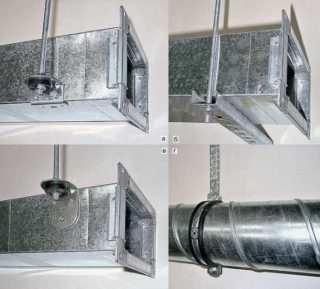
The main network of canals, shafts and branches cleans the microclimate from gas and other impurities, coordinates the intensity and pressure of flows, for this, a natural or forced method is used. Air ducts are classified depending on the purpose and technical parameters.
Classification by characteristics:
- cross-sectional shape: oval, round, square and rectangular;
- wall size, cross-sectional area, diameter;
- constructive model: longitudinal or spiral;
- mechanical rigidity or ability to resist deformation;
- production material: stainless steel, galvanized, plastic, metal-plastic;
- connection method during installation: without flanges or flanged.
It is important to use diffusers to slow the flow or convergers to accelerate. In the line, bends, tees, straight and transition fittings are used.
By hardness

Fastening of rigid air ducts is more often done, therefore a significant part of the equipment is guided by static air ducts. The channels are rectangular or circular in diameter. The material is rigid sheet metal or plastic. Steel channels are made on bending machines, and plastic elements are pressed through extruders.
They are used in conditions where durability of channels is required. Rigid lines are easy to maintain and install, and have high aerodynamic characteristics. The disadvantages include an increase in the weight of extended structures due to the many turns and adapters, therefore, additional fastening of the branch is required.
Flexible air ducts are a corrugated pipe, they are called spiral. Laminated foil walls are made on the basis of steel wire reinforcement. Flexible boxes are easily bent in the desired direction, do not require connecting elements. The inner ribbed wall reduces air velocity and increases noise levels.
Semi-rigid air ducts are made of steel or aluminum strips that are rolled up into a tube. Products have spiral side seams. Ducts are characterized by increased strength compared to flexible types and require almost no connecting and swivel fittings in the duct layout. The disadvantage is the same as that of flexible channels - a relief surface inside.
By form
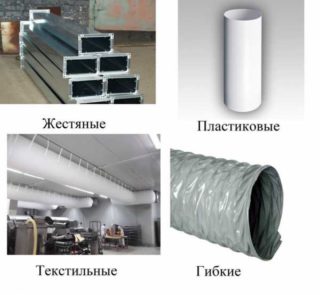
Round and rectangular boxes are more often used, in conditions of a lack of space, an oval shape is used. Such a cross-section of the pipe is obtained from a round one on technological equipment.Rectangular channels require more labor to manufacture, they consume 20 - 25% more metal than other types.
Round pipes provide high air velocity due to low wall resistance, they are distinguished by tightness, low noise level and less weight. Rectangular and square ducts are optimally placed in the space and adapt to the interior elements. In industrial buildings, air exhaust is organized with round pipes, and private buildings are installed with rectangular ventilation ducts.
By material
Boxes with galvanized walls are installed in a temperate climate with low aggressiveness of the ambient air, the temperature of which cannot be higher than + 80 ° C. The zinc layer on the surface protects against corrosion, extends the service life of the line, but adds to the cost of the ventilation system. Galvanizing is recommended for high humidity, because fungus and mold do not develop on the material.
Stainless steel can withstand ambient temperatures up to + 500 ° C, since it is heat-resistant. Air duct laying is done in industrial workshops with hot production. Thin sheet stainless steel is used without decorative coating or a polymer layer of different colors is sprayed on. The anti-corrosion properties of the metal are manifested due to the inclusion of phosphorus, chromium, copper and nickel in the chemical composition.
The walls of the metal-plastic duct have 3 layers:
- two outer layers of metal;
- foam plastic interlayer.
The structures are characterized by durability, do not require additional thermal insulation, but are distinguished by their high cost.
Plastic boxes made of modified polyvinyl chloride do not react to moisture, acidic and alkaline vapors. They are used for ventilation in pharmaceuticals, chemical and food industries. Smooth inner walls do not block flow and minimize pressure loss. Sometimes metal collectors are connected and turned with PVC elbows, elbows and tees.
Air ducts made of polyethylene and fiberglass are used in the supply sections of the system to connect the air distribution branch with the fan. Vinyl plastic types of boxes resist acid fumes, bend easily.
By isolation
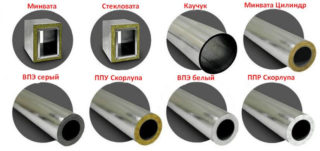
Installation of ventilation ducts is carried out inside the building and outside. Outdoor areas are isolated from the cold because the temperature difference causes condensation to drop out. Moisture contains acids and alkalis that destroy the walls of the ventilation shaft and shorten the service life of the line.
Used stone wool, fiberglass loose insulation. For rectangular boxes, sheet insulation is used in the form of polystyrene foam, polyurethane foam, foil-clad polystyrene foam. Indoors, this insulation is negligible.
Insulation is done from cold and noise. In the bedroom, nursery, study, living room, the walls of the duct are duplicated with sound-absorbing layers. The problem is solved by using three-layer pipes, for example, metal-plastic or installing vibration-damping devices in the system.
General installation rules
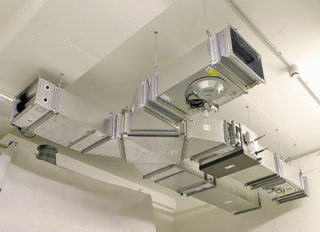
The scheme is drawn up so that the line has a minimum number of turns and connecting sections. At the technical design stage, the requirements for air exchange in the room are taken into account, the number of people and the volume of the room are taken into account.
The ventilation is fastened in the following sequence:
- before installation, the system is divided into separate branches, the length of which does not exceed 12 - 15 meters;
- connection points are put on the parts and holes are drilled;
- the elements of the line of a separate section must be fixed with bolts, clamps, the connections are fixed with tape or insulating sealant.
The assembled blocks and assemblies are combined into a single chain, the pipeline is fastened to the partition, wall, ceiling or removed through the roof.
Wall mount
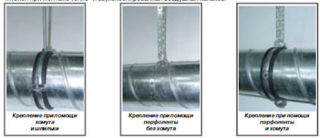
Clamps, supports, hangers are attached in increments of no more than 4 meters for the installation of horizontal air ducts. This step is relevant if the diameter of the round pipe or the largest side of the rectangular section does not exceed 40 cm.The step distance is reduced to 3 meters if the specified channel dimensions exceed 40 cm.
A step of 6 meters is provided for air ducts on the flanges of round or rectangular ducts with a maximum side of the cross-section up to 20 cm or insulated pipes of different cross-sections. If the dimensions exceed the specified value, the step is calculated in the project. Vertical fastening of ventilation pipes to the wall is carried out through a gap of no more than 4 meters. Mounting on the roof and outside of the building is indicated in the project and is accepted by calculation.
Ceiling mount
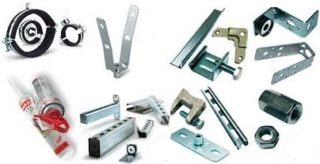
The air duct is attached to the ceiling in 50% of cases, if it is not possible to fasten the ventilation to the wall. Suspensions, pins and brackets are used for hanging.
Mounting options:
- Small pipes are hung with an L-shaped bracket, self-tapping screws are used. Suspensions are fixed to the ceiling or beam with dowels (into concrete), self-tapping screws (into wood).
- Z-shaped pins are used to install rectangular channels, and the fastening of the boxes to the ceiling is carried out in the same way as in the previous case. The extra angle on the bracket reduces the load on the supporting hardware and increases the strength.
- V-shaped hangers are fixed to the top floor with anchors. This type of suspension can withstand significant loads.
If the ceiling material is not suitable for fixing the duct elements, make vertical supports for the line. According to the norm, it is impossible to attach braces to the flanges, all suspensions must have the same tension. Hanging air ducts are fastened with double hangers if the size of the supporting elements is 0.5 - 1.5 m. The brackets are shot with dowels using a construction gun.
Standard distances according to GOST
The installation standards are spelled out in the document SNiP 3.05.01 - 1985, and when designing, the norms for the location of air ducts from SNiP 2.04.05.1991 are taken into account. The central axes of the highway should run parallel to the plane of the enclosing structures.
Standard distances are maintained:
- from the top of the round pipe to the ceiling should be at least 10 cm, and to the nearby walls - 5 cm;
- from a round channel to a hot and cold water supply, gas pipeline, sewage system must be at least 25 cm;
- from the outer wall of a square and round pipe to electrical wiring - at least 30 cm.
- when fixing rectangular air ducts, the distance to walls, ceiling and other pipelines is not less than 10 cm (width in section 10 - 40 cm), not less than 20 cm (width 40 - 80 cm), more than 40 cm (size 80 - 150 cm).
Connections of various types are placed at a distance of at least 1 meter from the place of passage through walls and ceilings.
Features of the installation of air ducts

A competently calculated ventilation line will not work effectively if the technology for installing elements into a common system is violated. The supply circuit includes one pipeline, and the supply and exhaust system provides for two independent channels for supplying a clean flow and removing exhaust air.
Outdoors, areas are protected from aggressive factors, for example, sunlight, frost, rain, icing. Flexible polyester air duct loses its shape if it is installed near the heating main.
Channels whose walls are made of different materials should also not be in contact to extend their service life.Static electricity has a negative effect on the walls of PVC pipes. Accumulation of the discharge in combination with explosive vapors can lead to accidents.
Mounting methods
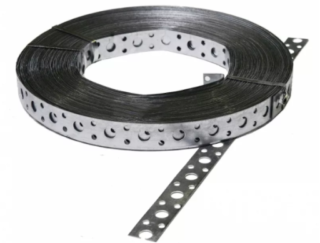
The stud and traverse method is used to hang rectangular ducts that are more than 60 cm wide. The traverse supports from below, and the side studs are fixed against sideways movement. This mount is suitable for insulated walkways as the integrity of the surface is not damaged by self-tapping screws.
The stud-and-clamp method is used to fix a circular pipeline. Fasteners are available in different sizes and have rubber seals inside to reduce vibration. A hairpin with a clamp is attached to the ceiling with a metal anchor or a plastic dowel (small-sized channels). The bottom of the mount is removed, a ventilation pipe is installed, then the clamp is tightened back.
The budget method with the help of punched tape is used for channels of different sections of light weight. Pieces of tape wrap around the pipeline and are fixed at the ends to the ceiling or beam. This method does not provide a rigid fixation, and the line under vibration can depressurize.
Stud and profile method is used for different section. Two curly parts are placed on the sides of the ventilation duct and screwed on with self-tapping screws. On one side there is a hole for connection with a stud, which is lined with a rubber seal to reduce noise and vibration.
Connection types
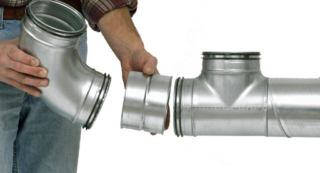
It is recommended to reduce the number of mating points, but it is difficult to completely avoid such areas. The assembly is carried out using a flange or shroud method.
In the first case, flanges with holes are provided on the mating surfaces of the shaped elements and the ends of the channels. The connection is made with self-tapping screws, bolts and nuts, rivets with a pitch of 20 cm. Some types of ventilation ducts are connected by welding. During assembly, rubber gaskets are used for sealing. The production of flanges is an expensive process and has rarely been used in recent years.
A flangeless or shroud interface is less expensive and requires less labor. A belt is used that is applied to the joint and is a strip of metal or plastic. The connection is characterized by low tightness, and with a temperature difference, condensation appears here.
Flexible duct
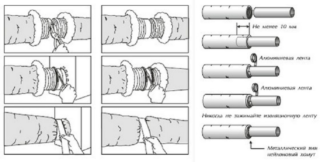
Corrugated sleeves without insulation have a length of 10 m, and with insulation they are produced in the size of 7, 6 meters. The diameter of such products ranges from 7 to 20 centimeters.
Installation features:
- before installation, flexible sleeves are stretched to the full length;
- there is an indication of the direction of the air on the packaging of the element, this designation must be taken into account during installation;
- the standard distance to adjacent pipelines and elements is maintained;
- the bending radius should not exceed the size of the double pipe diameter;
- for fastening, plastic clamps, adhesive tape with foil, clamps and hangers are used;
- special sleeves are used to pass through a wall or ceiling.
When connecting two sections, the branch pipe is put on to a depth of at least 5 cm. The joints are treated with sealing compounds. In isolated channels, before the connection, the edge of the insulation is turned off, and after the procedure, it is put in place and fixed.
Rigid duct
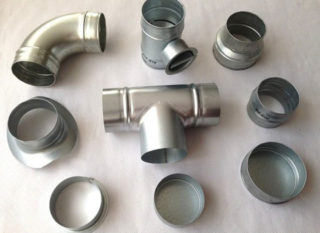
The metal sections of the ducts are connected on the floor, and in the assembly position they are installed in the complex using lifting equipment.
Installation rules for rigid lines:
- fastening of air ducts to the ceiling is carried out at the design marks or a beam system of vertical elements is installed for support;
- it is taken into account that space is required for the installation of scaffolding, scaffolding and lifting devices;
- all connections are made using gaskets, tightening and supporting clamps and sealing compounds are used;
- fasteners are mounted along a pre-applied marking line.
Attention is paid to the articulation of the last section of the duct with the outlet pipe to the outside of the building. Steel pipelines in industrial workshops are laid between load-bearing ceiling trusses. This method is more time consuming, but allows you to maintain the working height of the room.
Insulated duct
Difficulty arises when connecting sections, tees and bends. Shaped elements do not always have a layer of insulation, therefore, after completing the procedure, additional materials are placed on the surface of the flanges or fittings.
During connection and installation, you should try to damage the layer as little as possible, use side clamping strips to avoid the use of self-tapping screws. Fastening of thermal insulation is carried out using adhesive tape, clamps and aluminum tape.
Safety precautions when installing the duct
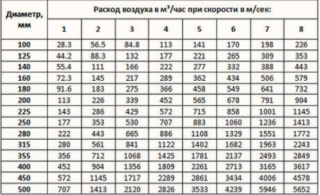
For work at height, reliable scaffolds (at home), certified scaffolding (on an industrial scale) are used. Safety belts must be used. Protective goggles and gloves are worn when working with cotton insulation, which emit fibrous impurities into the atmosphere.
The insulation is cut with a well-sharpened tool, preferably at a time, so that the material does not grind. If a harmful substance gets into the eyes, they are washed with a large volume of water and immediately consult a doctor. Specialists wear non-slip scaffolding shoes and safety helmets on their heads.
Selection and calculation of air ducts
The calculation of the cross-section and pressure in the duct is performed by technical specialists, it is difficult to do it yourself. The line is selected taking into account the required rate of air exchange per hour. The project takes into account the harmfulness of production, the number of people in the house or office. There are rooms from which air is removed in isolation and does not mix with flows from other rooms. These are chemical laboratories, hospitals, hazardous production facilities.
For private buildings, they take small-sized pipelines, attention is paid to high-quality cleaning of streams, humidification. The method of air movement is selected - natural or forced. The material of the boxes and the shape are determined by the technical characteristics, the preference of the customer and the interior of the room.








